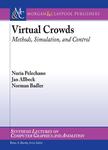版权所有:内蒙古大学图书馆 技术提供:维普资讯• 智图
内蒙古自治区呼和浩特市赛罕区大学西街235号 邮编: 010021

丛 书 名:Synthesis Lectures on Computer Graphics and Animation
I S B N:(纸本) 9781598296419
出 版 社:Morgan & Claypool Publishers
出 版 年:2008年
主 题 词:Computers amp the Internet Computer Animation
学科分类:08[工学] 0812[工学-计算机科学与技术(可授工学、理学学位)]
摘 要:There are many applications of computer animation and simulation where it is necessary to model virtual crowds of autonomous agents. Some of these applications include site planning, education, entertainment, training, and human factors analysis for building evacuation. Other applications include simulations of scenarios where masses of people gather, flow, and disperse, such as transportation centers, sporting events, and concerts. Most crowd simulations include only basic locomotive behaviors possibly coupled with a few stochastic actions. Our goal in this survey is to establish a baseline of techniques and requirements for simulating large-scale virtual human populations. Sometimes, these populations might be mutually engaged in a common activity such as evacuation from a building or area; other times they may be going about their individual and personal agenda of work, play, leisure, travel, or spectator. Computational methods to model one set of requirements may not mesh well with good approaches to another. By including both crowd and individual goals and constraints into a comprehensive computational model, we expect to simulate the visual texture and contextual behaviors of groups of seemingly sentient beings. Table of Contents: Introduction / Crowd Simulation Methodology Survey / Individual Differences in Crowds / Framework (HiDAC + MACES + CAROSA) / HiDAC: Local Motion / MACES: Wayfinding with Communication and Roles / CAROSA: Functional Crowds / Initializing a Scenario / Evaluating Crowds